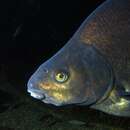fi
nimet breadcrumb-navigoinnissa


Leuciscinae is a subfamily of the freshwater fish family Cyprinidae,[1] which contains the true minnows.[2]
Members of the Old World (OW) clade of minnows within this subfamily are known as European minnows. As the name suggests, most members of the OW clade are found in Eurasia, aside from the golden shiner (Notemigonus crysoleucas), which is found in eastern North America.[3][4]
According to ancestral area reconstruction, the subfamily Leuiciscinae is thought to have originated in Europe before becoming widely distributed in parts of Europe, Asia and North America. Evidence for the dispersal of this subfamily can be marked by biogeographical scenarios/observations, geomorphological changes, phylogenetic relationships as well as evidence for vicariance events taking place through time.[5] Through analyses and evidence of divergence time, it was observed that the two monophyletic groups, the phoxinins and the leuciscins, had shared a common ancestor dating to approximately 70.7 million years ago, representing their lengthy evolutionary history.[6][7][a] The 5th edition of the Fishes of the World classifies the Leuciscinae as a subfamily of the Cyprinidae[1] but other classifications have resolved this taxon as a family, the Leuciscidae.[4]
According to a 2018 study, Leuciscinae may be subdivided into 6 clades, or, if Leuciscidae is treated as a valid family, subfamilies:[8]
{{cite journal}}: CS1 maint: uses authors parameter (link) {{cite journal}}: CS1 maint: uses authors parameter (link) Leuciscinae is a subfamily of the freshwater fish family Cyprinidae, which contains the true minnows.
Members of the Old World (OW) clade of minnows within this subfamily are known as European minnows. As the name suggests, most members of the OW clade are found in Eurasia, aside from the golden shiner (Notemigonus crysoleucas), which is found in eastern North America.
According to ancestral area reconstruction, the subfamily Leuiciscinae is thought to have originated in Europe before becoming widely distributed in parts of Europe, Asia and North America. Evidence for the dispersal of this subfamily can be marked by biogeographical scenarios/observations, geomorphological changes, phylogenetic relationships as well as evidence for vicariance events taking place through time. Through analyses and evidence of divergence time, it was observed that the two monophyletic groups, the phoxinins and the leuciscins, had shared a common ancestor dating to approximately 70.7 million years ago, representing their lengthy evolutionary history. The 5th edition of the Fishes of the World classifies the Leuciscinae as a subfamily of the Cyprinidae but other classifications have resolved this taxon as a family, the Leuciscidae.